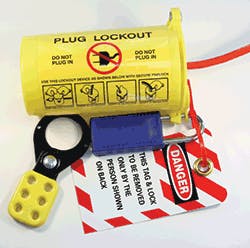Furniture giant Ashley Furniture Industries has been at the center of machine safety conversations since OSHA fined the company $1.76M in February.
More than 1,000 worker injuries – including multiple finger amputations – occurred at the company's Wisconsin site over the past 36 months. OSHA alleged the company didn't train workers on safety procedures and hazards present when servicing machinery, and did not equip some of its machines with readily accessible emergency stop buttons.
Ashley disputed the allegations, claiming the company trains its employees to follow applicable lockout/tagout procedures and safeguards for "minor" equipment servicing. "Ashley strongly disagrees with each and every opinion of the agency," the company noted, and has contested the citations – specifically when OSHA's lockout/tagout standard applies.
The case will now go to an independent review board, which could take up to a year to resolve, said Scott Allen, U.S. Department of Labor regional director for public affairs and media relations.
While the Ashley case made headlines, the citations only skim the surface of broader issues. Lockout/tagout was the sixth most violated standard of 2014, resulting in 3,117 OSHA violations. The New Year is off to a rocky start (see page 34).
Although OSHA hasn't recorded any deaths at Ashley facilities, these minor injuries – the pinches, cuts and lacerations – could just have easily lead to major amputations and even fatalities.
Additionally. a total of 717 fatal work injuries occurred as a result of contact with objects and equipment in 2013, according to the most recent Bureau of Labor Statistics fatalities report.
Another 105 workers were fatally injured after being caught in running equipment or machinery.
Lou Flores and his team of lockout/tagout technical representatives within the Washington State Department of Labor & Industries, Division of Occupational Safety and Health (DOSH) said minor injuries always are indicative of larger safety issues. When a series of minor machine accidents occur, safety managers should re-access safety training and hazard recognition.
Who Needs Lockout/Tagout Training?
- Authorized personnel: Individuals performing the actual lockout/tagout as defined in federal and state codes. Before the machine or equipment is turned off, the authorized employee must be knowledgeable of the following: recognition of applicable hazardous energy sources; details about the type and magnitude of the hazardous energy sources present; and the methods and means necessary to isolate and control hazardous energy sources.
- Affected personnel: Individuals who use the equipment in question on a regular basis. If a machine malfunction, routine maintenance or cleaning project occurs, the affected personal must contact authorized personnel to lockout/tagout the device.
- Other personnel: Managers, janitors, custodians – anyone who could be in the area where the lockout/tagout is performed. To prevent other personnel from being affected, companies can use blockade measures when a lockout/tagout occurs to prevent injury.
All employees are required to recognize when energy control procedures are being used, understand the purpose of the procedure and understand the critical importance of not attempting to start up or use equipment that has been locked/tagged out.
All affected employees must be trained on lockout/tagout procedures before work is performed, and businesses are encouraged to provide annual lockout/tagout employee training.
Hazard Recognition
Hazard recognition is an ongoing safety tool, but according to DOSH officials, most companies recognize hazards only after an injury has occurred. Leading indicator safety programs help companies address on-site issues to prevent the escalation of injuries.
Leading indicators measure the possibility of something unsafe occurring by combing data from audits, evaluations, specialty software and workers' reports. Programs vary by facility, but effective leading indicators commonly incorporate:
- Audits and assessments: Designated safety professionals tour the facility and gather data on a daily basis. Professionals provide observations and may conduct employee interviews.
- Perception surveys: Employees offer detailed feedback regarding the company's overall safety culture.
- Near-miss reporting: Employees document near misses as a means to address problem areas and weaknesses – be that machines or lack of training – throughout the facility.
While the safety program can be a huge undertaking, and is more commonly used in larger organizations likes the U.S. Army and Amazon, leading indicators give employers a larger picture of the overall safety operations in their facility.
While safety training and hazard recognition programs can improve the overall safety culture of a facility, new record-keeping updates also may help shed light on minor machine injuries and thereby prevent amputations and even fatalities.
Before 2015, companies like Ashley weren't required to report minor injuries. Now, all employers must report all work-related inpatient hospitalizations, all amputations and all losses of an eye within 24 hours. Industry professionals like those at Washington State DOSH anticipate the record keeping updates will garner more OSHA inspections – not necessarily citations – in the coming year.
Jordy Byrd, a public relations specialist with Graphic Products, writes about workplace safety and industrial hazards. Graphic Products is located in Beaverton, Ore.

